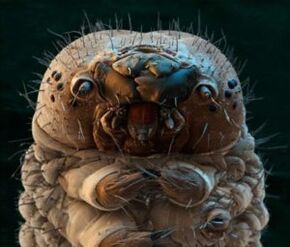
All kinds of parasites in the human body adversely affect its health. They infect organs, feed on nutrients necessary for human life, and release harmful toxic substances. That is why it is so important to get rid of them on time.
The human body is affected by various parasites, some of which live in the body, others on its surface. They differ in size, in the way they enter the body, in the characteristics of their vital activity.
Which parasites live in the human body? How can you get rid of them? What preventive measures are there? These problems are discussed below.
Parasite classification
Human parasites are very common, they are divided into groups:
- EndoparasitesOrganisms that parasitize within a person are named. This group is in turn divided into protozoa (consisting of a single cell) and helminths (worms). The simplest parasites in the human body are amoeba, lamblia, trichomonas and toxoplasma. The worms are also divided into round worms (nematodes), flat worms and tapeworms.
- Ectoparasites- These are organisms that parasitize on the surface of the human body - lice, ticks, fleas, insects. In addition to the fact that they feed on human blood, cause great discomfort (bites, burning, skin wounds), they carry quite dangerous diseases: typhoid, anthrax, trypanosomiasis and others.
Single-cell parasites:
- Giardia. . . Giardiasis infection is a fecal-oral mechanism. After cysts (parasites that have not yet formed, covered with a protective membrane) are removed from the anus of a sick person, they spread to vegetables, fruits and other foods. As a result of poorly washed hands, standing water, inadequately washed fruits and vegetables, cysts get into the human oral cavity, from where they safely enter the intestines, where they turn back into adults and reproduce again. The result is a vicious circle that will continue until appropriate treatment and hygiene measures are followed. The symptoms of the disease are weakness, fatigue, headache, diarrhea, abdominal pain, and gas. Itching in the anus, rashes, bronchial asthma can occur. The pathology is characterized by weight loss, anemia, and weakening of the immune system. Treatment is carried out with antiprotozoal drugs. The dosage is prescribed by the doctor.
- Toxoplasma. . . Infection with these protozoa occurs through contact with infected domestic animals. In this case, a person is an intermediate host, since the cycle of sexual development of the parasite takes place in the animal's body. The disease is manifested by a prolonged increase in temperature to subfebrile values, general signs of intoxication, in patients with enlarged lymph nodes there are joint and muscle pain. The functions of the gastrointestinal tract and eyesight are also disturbed, the central nervous system can suffer, there are signs of heart disease and the endocrine system. Complex treatment is prescribed - antibiotics of the tetracycline group and sulfonamides.
- Trichomonas. . . Trichomonas is sexually transmitted, the risk of infection through contact is minimal but still present. Symptoms of the disease in women include itching, redness of the genitals, burning sensation, and foamy discharge. Men may have difficulty urinating and have discharge. Treatment - anti-Trichomonas drugs.
Pinworm is an intestinal parasite
The most famous internal parasites are pinworms. They live in the intestines and cause a disease called enterobiasis. This type of parasite affects not only humans but also monkeys. Risk group - children of preschool age According to statistics, half of children aged 2 to 10 years are diagnosed with enterobiasis.
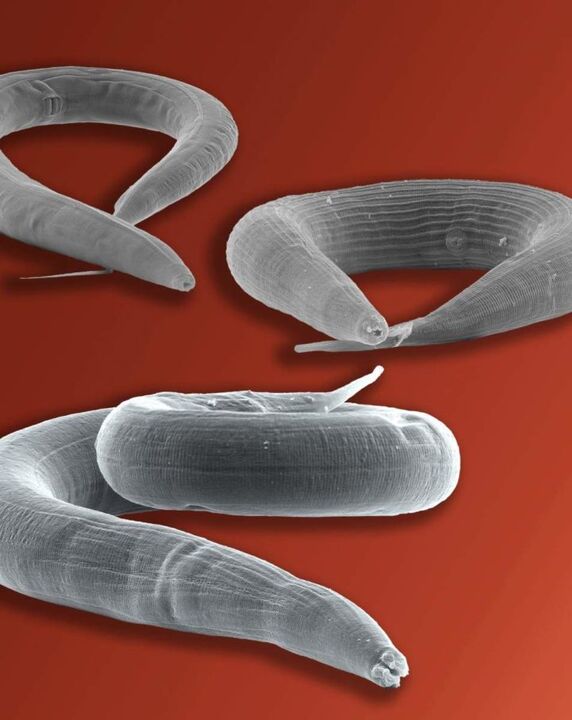
Worms are transmitted from person to person. You can get infected from anything used by a sick person or from a handshake. The main condition for pinworm egg transmission is that hands are not washed after contact, especially before eating. Worms, or rather their eggs, can be carried by flies and cockroaches.
Pinworms can only live in the intestine; they are particularly comfortable in thin sections, in the large intestine and in the appendix. For mating, the parasites select the ileum, from where the female crawls through the anus and lays eggs in the anus. The symptoms of pinworms in the body are itching in the anus, allergies, fatigue, anemia, abdominal pain, exhaustion.
For the treatment of enterobiasis, anthelmintics are prescribed. Pinworm prevention is based on hand hygiene. They need to be washed after visiting public places.
Roundworms - roundworms
The length of an adult can reach 40 cm. Roundworms live in the human intestine, their eggs are hatched naturally, then they continue to develop in the soil, where they remain until they get back into the human body. Dirty hands and unwashed vegetables and fruits can become infected with roundworms. Roundworm eggs are covered with a shell that does not dissolve in the human stomach, allowing roundworms to survive and enter the intestines, where mature individuals develop.
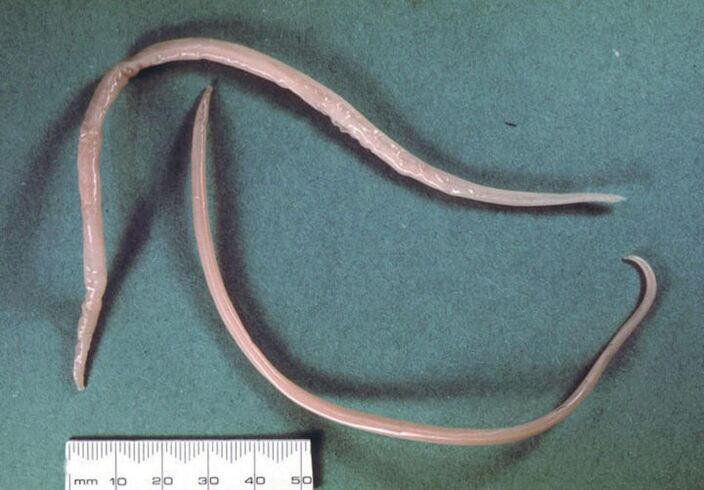
Ascariasis can be asymptomatic for a long time. Then symptoms appear, which depend on the location and stage of development of the parasite. In the first phase of migration of ascariasis, the patient is concerned about fever, cough with sputum, rashes, migraines, enlarged lymph nodes, liver and spleen. In the late phase, when the parasite has already entered the intestine, stool disorders are observed (dysentery, cholera-like symptoms, signs of typhoid may occur). There are painful sensations in the abdomen, severe weight loss and fatigue.
Broad tapeworm
The infection with this parasite occurs through fish. This is the worm's intermediate host. It is not necessary to eat for infection, sometimes just coming into contact with infected fish is enough. This is why it is so important to be very careful with your hands, knife and board after cutting the fish.
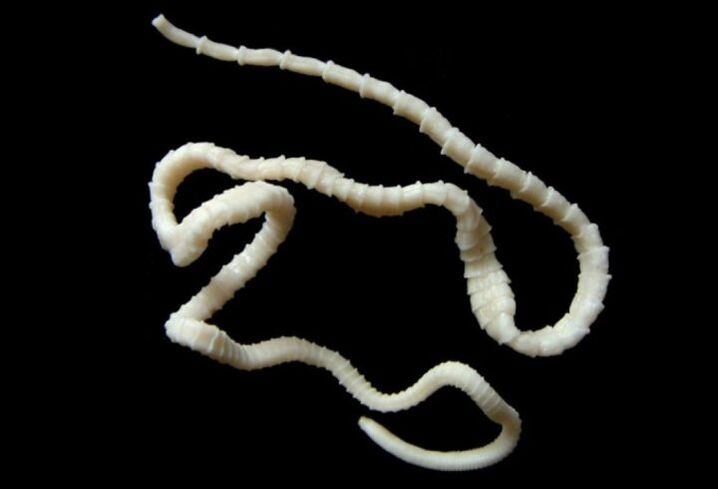
Neither worms nor their larvae are transmitted from a sick person to a healthy person. Symptoms of infection are nausea, vomiting, abdominal pain, increased or decreased appetite, dyspeptic disorders. The first signs of the disease may appear a month or two after infection. As a result of the long-term presence of the parasite in the human body, there are paleness of the skin, headache, increased heart rate, decreased blood pressure, weakness and anemia. Treatment is aimed at killing the worm. For this purpose, anthelmintics are used.
Beef tapeworm
Beef tapeworms can grow up to 12 m long. It is a hermaphrodite that can produce over 100, 000 eggs that are excreted in excrement. Eggs fall into the ground, then onto plants, these plants are eaten by cattle. In the body of an animal, eggs turn into larvae, which are localized in the muscles. When a person eats contaminated beef, the larvae enter the intestines. Larvae are not transmitted from person to person.
Adult worms have a head with four suction cups, a neck, and a body made up of segments. The number of segments is constantly growing, mature segments can separate from the worm and crawl out of the human intestine.
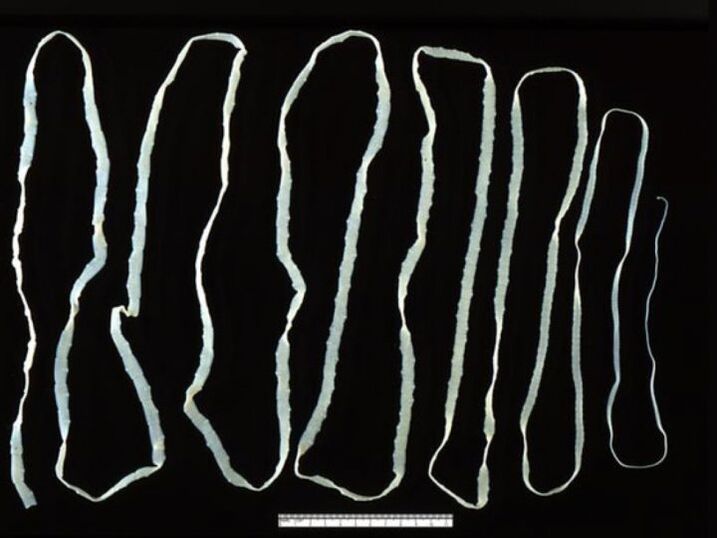
Symptoms of the disease are nausea, vomiting, dyspeptic disorders, increased salivation, dizziness, weakness, nervousness, fatigue, abdominal pain with uncertain localization, allergies, appetite fluctuations.
To remove the beef tapeworm from the body, there is a scheme that consists of three steps: preparation (cleansing the body), treatment with antiparasitic drugs, recovery (diet, herbal medicine).
Pork tapeworm
A person can get infected with pork tapeworm from dirty hands, poorly cooked meat, dirty water. An infected person can excrete segments and larvae of a tapeworm into the environment with vomit and feces.
The worm can live in the human body for up to 15-17 years, it adheres to the intestinal mucosa and its larvae can spread in the blood flow in the body and attach to all organs. It is especially dangerous when the larva gets into the brain.
Pigs are the intermediate host, and people who have frequent contact with raw meat are at greatest risk of contracting this parasite. The pork chain can become infected both from contact and from eating meat that has not been adequately heat treated. In order for all pork tapeworm larvae to be destroyed in the meat, the meat must either be boiled for a long time or frozen for 2-3 weeks.

Pork tapeworms can affect the small intestine, liver, brain, organs of vision, muscles, etc. If the tapeworm affects vital organs, a person can be paralyzed or even die.
Symptoms of pork tapeworm: appearance of allergic reactions, abdominal pain, nausea and vomiting, weakness, dizziness, headache, weight loss, itching in the anus. The worm infects the lining of the intestines, so the symptoms of enteritis are very similar.
Treatment consists of taking drugs that have a paralyzing effect on the worm, preventing it from sticking to the walls of the intestine and leaking out. At the same time, it gives off a large amount of toxic substances that can cause anaphylactic shock in a person. Therefore, treatment should only be carried out under the supervision of a doctor.
Parasites in the mouth
Parasites in the human mouth can most often be represented by the following types:
- Trichomonas;
- oral amoeba;
- Diptera larvae (oral myiasis).
The clinical picture can be as follows:
- Allergies;
- Weakness, weight loss;
- foul smelling odor from the mouth;
- a feeling of stirring in the larynx;
- Itching and sweat;
- Nausea, loss of strength.
Worms that live in the mouth can destroy teeth and cause purulent deposits on the mucous membrane and tongue. Treatment is prescribed only by a doctor, taking into account the symptoms present, as well as the types of parasites. The prerequisite for treatment is the examination of all persons who are in contact with the patient.
Sum up
Not all of them have been considered above, including the most common parasites that can live in the human body. It is important to understand the great danger of this neighborhood: worms in a person can have very serious consequences, and ultimately cause the death of their owner. Therefore, it is very important to diagnose parasites in a timely manner and get rid of them. Preventive measures consist mainly of hygiene and high-quality roasting of the meat consumed.





































